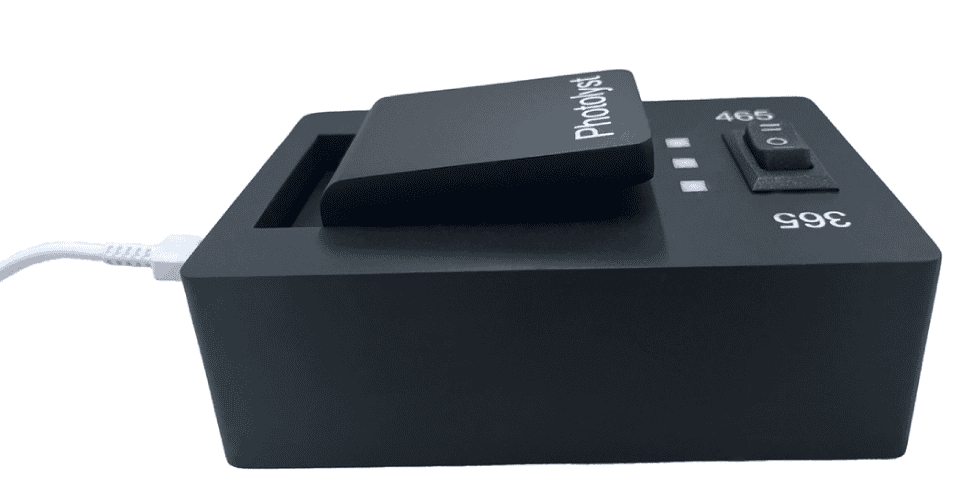
Photolyst™ X100
Photolyst™ X100 is a dual-channel, LED-based device used for the photoactivation of MycoLight™ vPCR350 and other similar photoreactive dyes, such as propidium monoazide (PMA), PMAxx and ethidium monoazide (EMA) in viability PCR applications.


This device contains two long-lasting LED lights, providing consistent illumination at either 365 nm or 465 nm wavelengths. The ability to toggle between two illumination sources enables the efficient activation of commonly available photoactivatable reagents using a single device.
Additionally, this device is compatible with ubiquitous and convenient to use PCR tubes, holding up to 200 µL of sample. A compact form factor allows for simple integration into existing lab workflow and serves as an excellent entry point into applications that require photoactivated dyes, such as viability PCR (vPCR).

Instrument Operation
1. Connect the provided USB-C cable into both the power adapter and the device power port (located on the back of the device).
2. Plug the power adapter into a power outlet that complies with the electrical requirements listed in the product specifications.
3. A white LED will turn on to indicate that the device is powered.
4. Flip the lid upward to open and access the sample holder of the device.
5. Place the sample (in 0.2 mL clear wall, polypropylene tube) inside the well of the Photolyst™ device.
6. Close the lid to limit exposure to high-intensity light.
7. Toggle the rocker switch to turn on either the 365 nm or
465 nm light. ⚠ UV light may be emitted from this product.
Ensure the lid is closed before turning on the light.
Avoid eye and skin exposure.
8. Leave the sample inside for the recommended time,
based on the experimental protocol, then flip the switch
back to its default (middle) setting to turn off the light.
9. Lift the lid and remove the sample for further
processing. Unplug the device to fully shut it off, or
repeat the steps above to begin the photolysis process
again.
Physical characteristics
Instrument type: Photolysis device
Instrument dimensions:
8.8 cm (w) x 12.7 cm (l) x 5 cm (h)
Weight: 280 g
Operating power: 240 VAC, 1.2 A
Frequency: 50 / 60 Hz
Electrical input: 5 V, 3.0 A
Installation site: Indoor use only
Operating temperature: 10 - 40 °C
Operating humidity: 20 - 80% (non-condensing)
Technical characteristics
Light sources: Near ultraviolet LED (max ~365 nm)
Blue LED: (max ~465 nm)
Tube type: 0.2 mL Real Time PCR (polypropylene) tub
Application Note
PCR can be used to quantify pathogenic DNA, but one big limitation is that it cannot distinguish between live and dead cells, leading to potentially inaccurate results. Viability PCR (v-PCR) is an advancement in PCR technology that uses a photo-reactive reagent to differentiate between living and dead cells.
MycoLight™ vPCR350, developed by AAT Bioquest, is a photoreactive dye derived from the popular v-PCR reagent
Propidium Monoazide (PMA). Upon activation by a 365 nm light source, MycoLight™ vPCR350 binds covalently to DNA, blocking amplification during PCR. Because the dye is cell membrane impermeable, it selectively inhibits amplification of DNA from dead cells, which have compromised cell membranes. Live cells, with intact membranes, prevent uptake of the dye, thereby leaving amplification of live cell DNA unaffected

Above Figure. Normalized qPCR curves were obtained from a viability PCR experiment involving live and heat-inactivated E. coli, treated
with MycoLight™ vPCR350. The qPCR analysis utilized primers targeting a region of the uidA gene. Treatment with MycoLight™
vPCR350 did not impact the amplification of DNA from live E. coli. However, it led to a notable delay in the amplification of DNA from heat-killed E. coli.
Need more information / Questions?
Need more information / Questions?
Please contact us by phone or email:
Freephone 0800 724 633
Or use the contact form below:
A to Z Product Listing
A to Z Product Listing
Copyright © 2025, Scienze. All rights reserved.